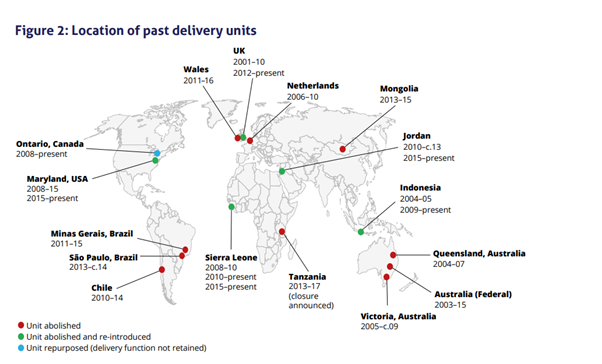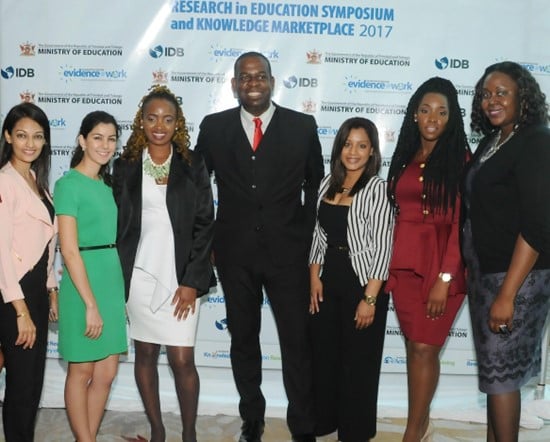Have you noticed the ‘labification’ of the policy field? Our research highlights the proliferation of new policy labs, delivery units and other related entities over the last 15 years.
But as fast as new labs are formed, others are dying. See this compelling illustration from the Institute for Government’s 2017 report.

Maybe this isn’t a bad thing. The authors of ‘Life Cycles of Public Innovation Labs’ view the death of labs as an opportunity for ‘rebirth’, taking on new/different forms. They argue that the mentorship and learning involved in their development are valuable and part of its legacy.
But it does raise the question of sustainability for policy labs. Of course, sustainability can mean many different things for them, including their structures disappearing.
Last month, OTT hosted a webinar to explore concepts of sustainability for a group of education policy labs (EdLabs) that aim to strengthen evidence use.
Throughout this article we share insights from the webinar, in which Ria Collingwood-Boafo talks about managing a technical cooperation grant between the Inter-American Development Bank and Trinidad and Tobago’s Ministry of Education. +
We use the terms ‘labs’ and ‘units’ interchangeably in this piece. We also refer to the full spectrum of units – from those embedded within a government agency to those independently run. +
It’s important to note that our research has not found that any of the above models are inherently more sustainable than others. However, as Ria’s presentation reminded us, focusing on the sustainability of the work (outputs and outcomes) of the labs can validate or support the structure.
In this article, we share three key principles and helpful tools that have emerged from our work to support policy labs in thinking about and planning for sustainability: demand, relationships, and human and financial resources.
Do you wish to receive more insights like this straight to your inbox? Subscribe to our newsletter
1. Demand
Demand is an important principle because it provides the foundation for ownership. And ownership is a critical element of sustainability – especially for externally funded units.
As the experiences from Innovations for Poverty Action (IPA) show, aligning with existing government structures and priorities can strengthen the demand for and uptake of the products and services offered by the labs.+
However, demand exists at different levels, and sometimes there are competing interests – for instance, a minister may want a lab but the civil servants may see it as a threat to their existing work.
Identifying and maintaining the right high-level political champion(s) is important groundwork for lab sustainability. As the IfG notes: “Civil servants are very attuned to whether you have the ear of the Prime Minister… As soon as people suspect that you don’t, then it’s over. It doesn’t matter how skilled and capable you are.”

Pictured: Ria Collingwood-Boafo (far right) and members of her team with Dr Lovell Francis (centre). +
Demand is also changeable. Our report found that labs often feel like they are walking a political tightrope: they don’t want to associate themselves too closely with any one political agenda, but they also need to maintain their relevance and build trust with political players to be able to inform policy decisions.
One practical tool to assess demand is the Triple A assessment, using a Problem-Driven Iterative Adaptation (PDIA) approach. This can be used to differentiate between buy-in from high-level ‘authorisers’ and the acceptance of those who will be implementing the lab.
A cautionary word came from one interview we conducted: despite being entirely government-funded and government-run, a lab had to assert its legitimacy within the government because it was perceived as being an external/donor-led initiative purely because of the strong influence of donors in similar efforts in the country.
Last but not least, demand changes over time as government administrations change. One way of navigating this is to think about relevance. As Ria advised – drawing on her experience of working with two ministers – establish and maintain relevance by adopting a proactive stance and responding to changing needs, while staying rooted in purpose.
2. Relationships
Relationships featured in everything we heard and read about the sustainability of labs. Key relationships are both internal and external:
- Internal: the ‘authorisers’ and ‘accepters’ within the host agency (namely, the government agency)
- External: stakeholders in other government agencies
As one interviewee told us: “if you really want sustainability, invest in the relationships that will last long after the [lab’s] structures are gone”.
In the webinar, Ria shared two important insights on relationships with us:
1. Relationships take time.
She shared a proverb that sums this up: “If you’ve got eight hours to cut down a tree, spend four hours sharpening the axe”.
In Trinidad, a big part of ‘sharpening the axe’ – a full three years of their six-year timescale – was spent on co-designing the unit’s approaches with key stakeholders. She and her team took a consultative approach and invested time in collaborating with stakeholders to understand their needs and priorities.
2. Take a robust approach to communications and engagement
This can support your relationships. Investing in branding and marketing the initiative from the beginning was an important part of her approach in Trinidad and Tobago, and one that the evaluation found to have been a key factor in its success.
However, Ria pointed out that there are also some practical, operational aspects of relationships to bear in mind when setting up a lab. For instance, physical location matters.
One lab in Tanzania was situated too far from the main government decision-making spaces; in heavy traffic, it was too onerous to simply ‘stop by’ to contribute to discussions in an agile and informal way.
3. Human and financial resources
Human and financial resources appear in the Triple A tool as ‘ability’. Many labs worry about planning for future funding and staffing (especially if it’s been launched through an initial donor-funded stage).
Ria’s experience showed how a multi-disciplinary team was fundamental to the strength of their initiative in Trinidad and Tobago. From the outset, the team was staffed with individuals
who possessed relevant expertise in marketing, stakeholder engagement and knowledge mobilisation, which built and leveraged relationships and strategic partnerships.
There are three staffing questions that labs need to consider, which are crucial for sustainability:
- Will the lab be staffed by civil servants or external employees?
- How will it deal with high turnover?
- What kind of leadership attributes are needed?
The IfG’s report offers a helpful overview of experiences from different countries.
Moreover, our interviews showed that capacity is not only an important factor among the lab staff but also for the decision-makers who will be using the lab’s services and products: Do they know how to use the lab or what questions to ask?
Together, these three sets of factors, can be seen to add up to ‘institutionalisation’ – a process of gradual maturation over time, which is explored in more detail in this WHO checklist.
This compelling example from Brazil, which compares the different fates of two evidence units under Bolsonaro, shows that these elements are key to resilience in the face of political turbulence. The sources of resilience that enabled one unit to survive this period included strategic relationships, and strong staff capacity, leadership and buy-in.
An important element to bear in mind throughout this process is the lab’s mandate. In many instances, we heard of a lab’s mandate or focus being diluted over time; the lab still existed in theory but was far from fulfilling its original purpose. This is one of the ‘red flags’ included in the IoG’s helpful warning signs checklist for embedded labs.
As we highlighted in our report, the proliferation of lab models stands in stark contrast to the dearth of evaluations of their effectiveness. But there is, nevertheless, a rich array of insights from the collective experience of implementing units that can help labs plan for sustainability.
To turn these thoughts into practical plans for sustainability, we’d recommend starting with the PDIA approach, the IoG Warning Signs Checklist and the WHO Institutionalisation Checklist.
We look forward to hearing what tools our readers/community members would recommend!
This blog shares material from OTT’s work as part of a project providing technical advisory support to EdLabs work to strengthen evidence use in education policy, funded by the Jacobs Foundation.

